Friday 4 November, 2005, 23:20 - Much Ado About Nothing
A lot has been made in the British press recently of a test which is being introduced by the Home Office to assess immigrants' knowledge of Britain - the 'Britishness Test'. Amongst the many peculiar questions raised in the test, newspapers and television channels alike have reported with surprise that in the UK there are two numbers which can be used to call the emergency services (police, fire, ambulance and coastguard): 999 and 112. Most UK residents would be able to tell you that 999 is an emergency number, however few, if any, would be aware of the existence of the second option, 112. Which is quite amazing when you consider that 112 has been an emergency number in the UK for nearly 15 years. It stems from one of the (in my opinion) more sensible European Commission decisions (91/396/EEC) which requires all European Union (EU) Member States to adopt 112 as an emergency number by 31 December 1992. At the same time, the international access code was harmonised across EU countries to be 00 through a sister decision (92/264/EEC) to be implemented in the same time-frame.
Most UK residents would be able to tell you that 999 is an emergency number, however few, if any, would be aware of the existence of the second option, 112. Which is quite amazing when you consider that 112 has been an emergency number in the UK for nearly 15 years. It stems from one of the (in my opinion) more sensible European Commission decisions (91/396/EEC) which requires all European Union (EU) Member States to adopt 112 as an emergency number by 31 December 1992. At the same time, the international access code was harmonised across EU countries to be 00 through a sister decision (92/264/EEC) to be implemented in the same time-frame.The great thing about 112 is that you can use it in any EU country to get through to the emergency services, regardless of which country you are in. Of course if you don't happen to speak Czech, Slovenian or Estonian, this may be of limited use but it's a nice idea. And if you're visiting London you're in luck as the Metropolitan Police's call centre which handles emergency calls have been trialling a system which allows them to deal with calls in 150 different languages, particularly those which reflect the diverse ethnic make-up of this sceptred isle (Portuguese, Turkish, Punjabi, Spanish, French and Somali being the most common in London).
1 comment
( 1223 views )
| permalink
| 



 ( 2.9 / 2573 )
( 2.9 / 2573 )




 ( 2.9 / 2573 )
( 2.9 / 2573 )
Thursday 3 November, 2005, 10:36 - Pirate/Clandestine
Any illegal radio transmission runs the risk of being tracked down by the relevant authorities who use sophisticated equipment to monitor the spectrum for unlicensed transmissions. Such equipment is capable of pin-pointing the location of a given transmitter to within a few hundred metres in under a second and together with mobile and hand-held equipment can track down an illegal transmitter with no difficulty. 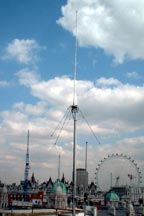 This is easier at VHF and UHF frequencies than it is at frequencies below 30 MHz, as the line-of-sight nature of propagation at these higher frequencies simplifies the tracking operation. At frequencies below about 30 MHz, the accuracy of most of the equipment begins to fall and large, fixed stations are needed to produce any level of detail. Such stations do exist though, and given the fact that MF and HF signals travel large distances, a few of these fixed monitoring stations in two or three neighbouring countries can work together to identify the location of an illegal transmitter (which the mobile teams can then home in on).
This is easier at VHF and UHF frequencies than it is at frequencies below 30 MHz, as the line-of-sight nature of propagation at these higher frequencies simplifies the tracking operation. At frequencies below about 30 MHz, the accuracy of most of the equipment begins to fall and large, fixed stations are needed to produce any level of detail. Such stations do exist though, and given the fact that MF and HF signals travel large distances, a few of these fixed monitoring stations in two or three neighbouring countries can work together to identify the location of an illegal transmitter (which the mobile teams can then home in on).It amazes me, therefore, that there are so many pirate radio stations who continue to operate 24 hours per day, 7 days per week. A quick tune across the FM dial in London at lunchtime in the middle of the week yielded the following stations happily pumping out pumping tunes:
87.9 Shine 879
91.8 Passion FM
93.8 Vibes FM
95.4 Roots FM
97.9 Bassline FM
101.2 Unique
101.9 The Beat
Now it's fair to say that many of these stations are regularly closed down by the authorities, but have sufficient funding and expertise to be back on the air in short shrift. They also tend to use a complicated set of links to connect the studio to the transmitter site such that if the transmitter site is identified, the studio location (where the more expensive equipment and the presenter are located) remains secret. A studio hit on a pirate costs much more to recover from and often leads to prosecution.
It's also fair to say that these staitons have, on the whole, managed to settle on frequencies that tend to minimise the amount of interference they cause to the legal stations. Many pirate stations in London operate only 200 kHz away from legal stations which is far too close to prevent interference (the reasons for which are something to talk about on another day perhaps), but all these stations sit sufficiently far enough away from legal stations (typically a minimum of 400 kHz) that the interference they cause is relatively small. The fact that they are all in mono also improves the situation (and has the bonus for the pirate station that their coverage area is increased). Nonetheless, these stations do cause interference, especially close to the transmitters concerned where the sheer power of the illegal signal overwhealms nearby receivers and the authorities tend to act more virulently where a complaint of interference has been received.
However these aren't the only long-term illegal transmissions that can be found. A recent scan of the short-wave broadcast bands brought to my attention 'Laser Hot Hits' - a pirate station that broadcasts 24/7 on a number of short-wave frequencies (try 4025, 6219, 6285, 7460 and 9385 kHz, though the 7460 kHz signal is often wiped out by a strong BBC DRM transmission from Kvitsoy in Norway on 7465 kHz in the afternoons). What makes this more intriguing than the London pirate situation is that many of the frequencies they are using will cause significant interference not, in this case, to other broadcasters, but to maritime, aeronautical and defence spectrum users, yet their transmissions have remained on-air, seemingly unchecked for many months now. In particular, the 6219 kHz transmission will directly interfere with safety-of-life, emergency maritime communications on 6215 kHz.
So how come they are still on-air? One possibility is that their transmitter site location (not needing to be near to the listeners due to the propagation at HF) is somewhere so remote that the authorities either can't, or can't be bothered, to get to it. A persistant pirate of the late 1980's, 'Radio Fax' used to transmit from a rural location in Ireland and the Irish authorities who have always been much more tolerant to pirate transmissions than many other countries, were very sluggish to step into action. Maybe Laser Hot Hits' transmitter site is on one of the mountains of the Netherlands, which the local mountain rescue teams can't reach! Wherever it is (or they are - there is no reason to suspect that all the frequencies are transmitted from the same site) they have obviously escaped scrutiny so far.
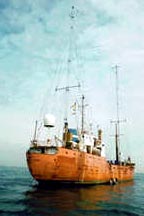 So what conclusions can we draw from this? Perhaps those in power accept 'pirate radio' as a problem that will never go away and for stations who act responsibly turn a blind-eye (remember that pirate radio has had a greater impact on the shape of the UK radio industry than possibly any other factor, and even has a major impact today). Perhaps they do not have the resources to track down every station and concentrate on those who cause the biggest sores (e.g. those with outspoken political views or whose transmitting equipment is of low quality and is causing lots of interference). Perhaps they wait for compliants to be raised before tackling the problem. Whatever the reason, one must doff one's cap to those who continue to flout the law for our entertainment. Many are outlets for music which ordinary stations turn their back on but which has a large, cult, following. Some are there just for the fun of it (don't tell me that doing something naughty isn't at least a little bit thrilling...?) Gentlemen (and ladies), I raise my glass to you.
So what conclusions can we draw from this? Perhaps those in power accept 'pirate radio' as a problem that will never go away and for stations who act responsibly turn a blind-eye (remember that pirate radio has had a greater impact on the shape of the UK radio industry than possibly any other factor, and even has a major impact today). Perhaps they do not have the resources to track down every station and concentrate on those who cause the biggest sores (e.g. those with outspoken political views or whose transmitting equipment is of low quality and is causing lots of interference). Perhaps they wait for compliants to be raised before tackling the problem. Whatever the reason, one must doff one's cap to those who continue to flout the law for our entertainment. Many are outlets for music which ordinary stations turn their back on but which has a large, cult, following. Some are there just for the fun of it (don't tell me that doing something naughty isn't at least a little bit thrilling...?) Gentlemen (and ladies), I raise my glass to you.Thursday 27 October, 2005, 09:45 - Licensed
Posted by Administrator
Posted by Administrator
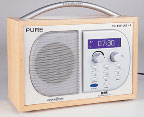 After many years in a sleepy backwater, Digital Audio Broadcasting (DAB) in Europe is finally becoming more mainstream (with one or two exceptions). This is certainly in part due to the fact that the prices for DAB receivers have now dropped to the level where, when buying a new radio for the kitchen, a DAB radio is in the running; and with the extra stations and 'improved quality' they offer, DAB radios are now becoming a must have item.
After many years in a sleepy backwater, Digital Audio Broadcasting (DAB) in Europe is finally becoming more mainstream (with one or two exceptions). This is certainly in part due to the fact that the prices for DAB receivers have now dropped to the level where, when buying a new radio for the kitchen, a DAB radio is in the running; and with the extra stations and 'improved quality' they offer, DAB radios are now becoming a must have item.However, the gradual move towards DAB brings with it a problem for local FM broadcasters whose coverage is limited to a relatively small geographic area. For you see, DAB works by means of a multiplex (mux), whereby a number (typically 8 or more) stations are combined together and transmitted from one or more transmitter sites. The content of the mux must remain identical on all the sites such that all the stations on the mux achieve exactly the same coverage area. This is fine for national stations and for those who cover a relatively large geographic area, or the same city, such that there are likely to be other broadcasters who wish to achieve the same coverage and could share a multiplex; but who would wish to share a multiplex and duplicate the coverage of a neighbourhood or a small rural enclave? The straighforward answer is no-one! So these small scale stations are left with no option other than to continue using FM and hope that DAB does not become the de facto broadcasting standard.
Salvation, however, may come in another form of digital radio, otherwise known as Digital Radio Mondiale (DRM). DRM is designed to offer a replacement for outmoded AM radio on the long, medium and short wave bands, but it has recently had its frequency range extended to 120 MHz so as to offer a possible replacement for FM broadcasters too. For existing AM broadcasters, a move to DRM offers the chance to replicate their existing coverage but with much improved quality ('near-FM quality' is often quoted as being achieveable in an AM channel using DRM).
For AM broadcasters, this is great news: Using the same spectrum they can improve their transmission quality and many broadcasters, especially in mainland Europe, have already done so.
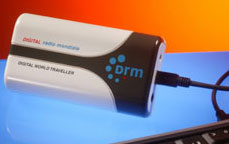 Using DRM in the FM band is a largely untried quantity and in theory there is no reason why it could not only work but at the same time expand the number of stations that could be broadcast in the FM band, as a DRM transmission takes up only about one tenth the bandwidth of an analogue FM transmission. It may not, though, be an ideal solution for a local FM broadcaster, particularly as at present, the very few receivers that exist for DRM do not cover the FM band (the manufacturers assumed that the standard would only be used on the HF bands below 30 MHz). Also (and I'm sure there are cleverer people than me working on this), the carrier spacing for the OFDM signal of a DRM transmisison varies between 41.66 and 107.5 Hz. At a frequency of 108 MHz, a vehicle travelling at 250 km/h (a train for example, or a BMW on a German motorway) experiences a Doppler shift of 25 Hz. Compared with the 41.66 Hz carrier spacing this is significant, and even at 107.5 Hz carrier spacing it represents a significant difference for the receiver to have to track, and must introduce lots of errors in reception.
Using DRM in the FM band is a largely untried quantity and in theory there is no reason why it could not only work but at the same time expand the number of stations that could be broadcast in the FM band, as a DRM transmission takes up only about one tenth the bandwidth of an analogue FM transmission. It may not, though, be an ideal solution for a local FM broadcaster, particularly as at present, the very few receivers that exist for DRM do not cover the FM band (the manufacturers assumed that the standard would only be used on the HF bands below 30 MHz). Also (and I'm sure there are cleverer people than me working on this), the carrier spacing for the OFDM signal of a DRM transmisison varies between 41.66 and 107.5 Hz. At a frequency of 108 MHz, a vehicle travelling at 250 km/h (a train for example, or a BMW on a German motorway) experiences a Doppler shift of 25 Hz. Compared with the 41.66 Hz carrier spacing this is significant, and even at 107.5 Hz carrier spacing it represents a significant difference for the receiver to have to track, and must introduce lots of errors in reception.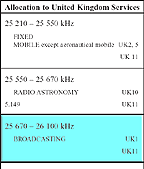 There is another cat in a bag which offers a potential solution to the question of a digital replacement for local FM broadcasting in the shape of a little used HF broadcast band. The 11 metre band (25670 - 26100 kHz) is virtually unused by broadcasters as, other than at the peak of the 11 year sunspot cycle, propagation is virtually non-existent except for local ground-wave coverage. During the day at the peak of the cycle, signals travel thousands of miles, especially trans-equatorially (i.e. north to south and vice versa). Experiments have been conducted in Germany which showed that using DRM in the 11 metre band offers good local coverage similar to that which FM enjoys, however there is the potential for occasional long-distance interference during the day. This is, if anything, an improvement on the situation which traditional AM broadcasters enjoy in which there is a virtual guarantee of interference from distant stations every night!
There is another cat in a bag which offers a potential solution to the question of a digital replacement for local FM broadcasting in the shape of a little used HF broadcast band. The 11 metre band (25670 - 26100 kHz) is virtually unused by broadcasters as, other than at the peak of the 11 year sunspot cycle, propagation is virtually non-existent except for local ground-wave coverage. During the day at the peak of the cycle, signals travel thousands of miles, especially trans-equatorially (i.e. north to south and vice versa). Experiments have been conducted in Germany which showed that using DRM in the 11 metre band offers good local coverage similar to that which FM enjoys, however there is the potential for occasional long-distance interference during the day. This is, if anything, an improvement on the situation which traditional AM broadcasters enjoy in which there is a virtual guarantee of interference from distant stations every night!Experiments using the 11 metre band are continuing in Germany and France and in London by WRN (1kW on 26070 kHz from Crystal Palace) and if all goes well, I think we could see a raft of local stations opening up DRM transmissions in this band, complementing their FM coverage and giving them a digital outlet to compete with the growing number of DAB stations. For the sake of small local radio stations, let's hope so.
Thursday 20 October, 2005, 09:07 - Radio Randomness
You often read about 'strange signals' being heard on various frequencies; there are lots of web-sites which provide listings of the frequencies on which these oddities can be heard. But I was surprised to discover that there are some weird goings on in the amateur bands. Not, that is, because they are in any way sacrosanct, but because these things often occur in the 'twighlight zone', i.e. those frequencies which don't seem to belong to anyone in particular because they sit between Fixed, Mobile, Amateur, Broadcasting and other allocations.My attention was drawn to 'Cluster Beacons': a series of CW (Morse) transmitters which are clustered very closely together in frequency and do nothing other than transmit the same letter over and over (and over) again. Such beacons have apparently been heard in the 40m amateur band occupying frequencies on or just below 7039 kHz. Now usually such things can only be heard by people with mile-long multi-element beam antennas and ultra sensitive receivers so I tuned my receiver to the frequency in question expecting to hear absolutely nothing (always the optimist). To my surprise, not only were these cluster beacons audible but (especially during the hours of darkness) they put quite a good signal into the UK. In particular the 'C', 'D', 'O' and 'S' beacons are audible for most of the day.
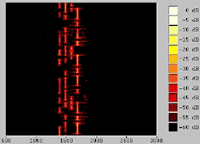 Not much is officially written about what the purpose of such beacons might be, however the received consensus is that they are either for monitoring propagation or are for navigation (the spectrogram on the right shows a waterfall of one of the clusters in action). What is known is that they come from various cities in the Former Soviet Union; each city is represented by a unique letter. This is a list I found elsewhere, I have no idea how accurate or up to date it is:
Not much is officially written about what the purpose of such beacons might be, however the received consensus is that they are either for monitoring propagation or are for navigation (the spectrogram on the right shows a waterfall of one of the clusters in action). What is known is that they come from various cities in the Former Soviet Union; each city is represented by a unique letter. This is a list I found elsewhere, I have no idea how accurate or up to date it is:'A' Unid.
'B' Archangelsk
'C' Moscow
'D' Odessa
'F' Vladivostok
'K' Peteropavlovsk Kamchatskiy
'L' St. Petersburg
'M' Magadan
'O' Moscow
'P' Kaliningrad
'R' Izhevsk
'S' Arkhangelsk
'V' Khiva
As well as being clustered around 7039 kHz in the 40m amateur band, other cluster hot-spots are noted as being 5154, 7039, 8495, 10872, 13258, 16332 and 20048 kHz. I checked these and found that as well as those around 7039, beacons around 10872, 16332 and 20048 kHz were audible during the day (as of October 2005).
Whatever purpose these beacons officially serve, they are useful as a propagation check, if you happen to want to use HF to be communicating with Russia. Alternatively, if you can find a nice clear frequency where only the beacons are audible, the gentle tonal pulsating of the beacons is strangely hypnotic!

